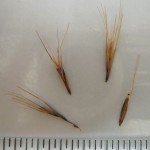Scientific Name: Bromus tectorum
Family: Poaceae (True Grass Family)
Other common names: Downy Brome
Life-Cycle: Annual, that reproduces by seed and sprouts soon after snow melts and often again in the early fall.
Weed Guide > Cheatgrass
Cheatgrass

| Description | Bloom (varies by elevation) |
What to Do | When? | Invades Undisturbed Land | State Class |
|---|---|---|---|---|---|
| First grass to appear; short and soft; dropping seed head; quickly turns a light red-brown; seeds stick in socks; pervasive. | Bright yellowish-green seed-heads form in early spring then open and turn light red-brown. New sprouts grow until snow-fall. | Early in season, mow or weed-whack large patches of seedlings before "bloom", and hoe or hand-pull small patches. Bag-up hand-pulled plants if the seed-heads are open. | As early as possible, then through summer and fall. | Yes - making it one of the most invasive weeds in the West. | Not listed; too pervasive. |
General Description
- Cheatgrass is probably the most common plant in the Columbia Basin, and it's one of the most widespread invasive (non-native) grasses in North America.
- It can grow almost anywhere, but prefers dry roadsides, pastures, rangeland and any disturbed soil, though it can sprout in undisturbed soil.
- It is an aggressive invader of our native bunchgrass and bitterbrush shrub-steppe habitat, but is also found among Ponderosa pines and Douglas fir.
- Stems are usually single-stalked and anywhere from 4"-24" tall. The top of the stem has several sets of seed-heads, which are compact and erect at first and then droop or nod, creating a soft, flat appearance from a distance.
- The seedheads have sharp tips with barbed ½ inch long spikes (awns) sticking out. Seeds easily stick to and through shoes and socks, poking the walker. Awns can burrow into animal skin (and dog ears), causing pain and often a trip to the vet.
- Leaf blades on the stem are up to 8 inches long, flat, relatively narrow, and usually 1/8 to 3/16 inches wide. Leaf sheaths and blades are densely covered with soft hair.
- Roots are short and branching, and usually quite shallow.
- Plant turns a dull red-purple color as it matures and tan-buff when dried.
Life-Cycle
- Cheatgrass has a very short life cycle and is a prolific seed producer.
- It is a "winter annual," meaning it usually germinates in the fall and sprouts in the winter (often under snow) and as soon as ground is snow-free in the spring.
- It sprouts and greens-up very quickly in the early spring, flowers (yes, grasses have "flowers"), is wind or self-pollinated, and then, seeds drop and/or attach themselves to animals and people who pass by. Plants die after seeding; plants that sprout early in spring are normally dead by mid-summer.
- Cheatgrass may also sprout in the fall, flower, and set seed before winter.
- Cheatgrass seeds generally germinate when conditions are favorable, but can remain dormant in soil for several years.
Why is Cheatgrass a Problem?
- Cheatgrass grows and matures earlier than any other plant in the shrub-steppe, stealing water from the top foot of soil and usually dying before the hottest and driest part of summer. This gives it an advantage over native grasses and other plants.
- Cheatgrass makes great fuel for wildfire because it is usually dead and dry by mid summer and burns easily and quickly. Research shows that where cheatgrass is abundant wildfires occur earlier and more often, damaging or killing native shrubs that take longer to grow back. Cheatgrass seeds in the soil take advantage of the nutrients fires release to grow large and produce abundant seed (over a thousand per plant in some cases). The season after a fire, cheatgrass quickly colonizes bare ground, making it more difficult for native plant species to recover. Over time, a decrease in native shrub-steppe plants corresponds to a decrease in native wildlife species - from rodents and songbirds to mule deer and golden eagles - because many shrub-steppe animals depend on forbs and shrubs for food, cover, and/or nesting.
Prevention & Control
Prevent
- Eradication of cheatgrass from large areas is not easy. Efforts should focus on reducing cheatgrass dominance and increasing perennial vegetation.
- To reduce the invasion of cheatgrass (and other weeds), always avoid disturbing soil.
- Take care not to bring in seeds on your clothes, shoes, pets or gear.
- Burning will not control a cheatgrass infestation, and can in fact worsen it.
Hand-Pull
- On small or sporadic patches of cheatgrass, hand-pulling can be easy and effective, as long as it is done while seeds are still on the plant. Bag-up the plants and throw in the trash. Even non-open seed-heads or flowers can germinate.
Mowing, Grazing, Cultivation & Biocontrols
- Cutting (mowing or weed-whacking) before seeds ripen is not effective unless it is done repeatedly until soil moisture is too low to permit further growth.
- Some stock animals will browse young cheatgrass.
- There is potential for biological control with naturally occurring soil-borne organisms, but this is not yet available.
Chemical
- Non-selective" herbicides (like Roundup) will kill cheatgrass but they will also kill any other plant nearby too, and in large areas, is not cost-effective.
See the whole “Toolbox of Weed Control Methods” for more details.
Interesting Tidbits
- The presence of "cryptobiotic crust" - living, biological soil on thesurface of pristine shrub-steppe land - can prevent cheatgrass from germinating.
- One home brewer in Nevada has started make Cheatgrass Beer!